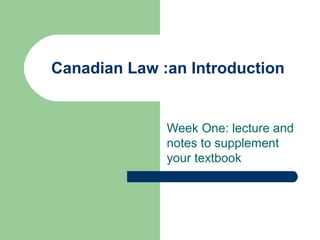
Canadian law chapter one
- 1. Canadian Law :an Introduction Week One: lecture and notes to supplement your textbook
- 2. What are the goals of this lecture? To describe why it is important to study the Canadian Legal system To review the role of law and the theories of law from Chapter One of the textbook To define the important ideas and terms in the Canadian legal system To describe the branches of government
- 3. Why study the Canadian legal system? Canada has a highly developed legal system based primarily on the British tradition As a Canadian it is important to understand basic Canadian law and how the legal system operates as we are regulated by law in all aspects of our lives Law plays an important role in Canada as our society is so diverse
- 4. Why is law so important in Canada? Because Canada is such a diverse nation with peoples from many cultures, the law and the rule of law is the glue that binds our cultural mosaic together Other countries have stronger uniform cultures and the norms and folkways of their countries guide their citizens. Canada has diverse cultures and we need law for stability and guidance.
- 5. What is law? James (p.5) defines law as: “a set of rules which are generally obeyed and enforced within a politically organized society” Imposed by the ‘sovereign’ Aim of the law is a better civilization
- 6. What are the traditional theories of law? Philosophy or theory of law is the lens through which we see the law. It influences how a Judge, perceives the issues and appreciates the consequences. Some major theories are: Positivism Natural legal theory Realism Critical theories
- 7. What is Positivism? The validly enacted law (posited law by the sovereign) should be followed Looks at the form and structure of the law, not the moral or social content The law is the law. A positivist asks what the law is, not what the law should be Helps keep society stable, law is predictable and consistently applied This is the most widely held view
- 8. What is Natural Legal Theory? A naturalist believes in a higher system to which mere positive law should conform Positive/ man made law must conform to natural order or law Morality and the law must combine Tradition based on religious ideas and Greek ‘objective morality’ The basis of civil rights Helpful in environmental law, changing times
- 9. What is Realism? We must look beyond the law and take into account ‘extra-legal’ factors such as public opinion, circumstances, changing times Law must be viewed in the context of society Looks beyond the facts in evidence and cold legal rules
- 10. What are Critical Legal Theories? Examples are Marxism, Radical Feminism, Critical Legal Theory Marxist theory is based on economic equality Feminists believe the legal system is peopled mostly by males and favors their interests Critical legal theory is the idea that the law, because of its historical development and because it is a tool for the rich and powerful, is dysfunctional and limited. It challenges the very basis of the legal system and process
- 11. What are some main ideas and terms in the Canadian system? Constitutional monarchy Democracy Federal state Parliamentary supremacy Responsible government Rule of Law
- 12. What is the Rule of Law? A fundamental principle of democracy. No one is above the law and all people are equal before and under the law Examples of rule of law in action: Roncarelli v. Duplessis and the Arar case Law must be: _ General – Public – Prospective – Clear – Consistent – Capable of being followed – Stable – Enforced
- 13. What are the main branches of Government? The Separation of Powers: Judicial Legislative Executive Unitarycourt system Administrative tribunals
- 14. What is the Consensus View? This is the view that our laws are made by consensus. We democratically elect our government who make our laws for the benefit of all. For the most part, the public agrees with the law. E.g. murder
- 15. What is the Conflict view? The view that the rich and powerful in society make the laws for their vested interests and their benefit, to the detriment of the poor and underclass. E.g. treatment of ‘white collar’ criminals, racial profiling etc.